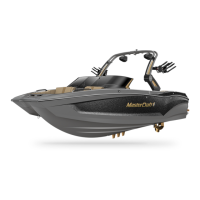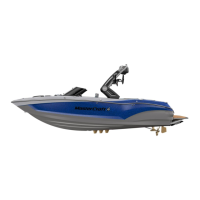• Verify the coupler latch and all equipment that connect the trailer
and tow vehicle are properly secured and adjusted.
• Verify that there are no leaks in the hydraulic system.
• Verify the safety cables are properly attached to the tow vehicle.
• Verify the emergency brake cable is attached properly to the tow
vehicle.
• Verify the boat is properly loaded on the trailer and properly tied
down to the trailer.
• Verify and/or correct tire pressure on both the tow vehicle and
trailer.
• Ensure the lug nuts are properly torqued. (This must also be done
after the first 25 miles of towing and every 100 miles thereafter,
at a minimum. MasterCraft recommends checking this more
often. At each fuel or rest stop is not excessive.)
• Verify the wheel jack is retracted and in the locked position prior
to towing.
• Verify the tow vehicle has not exceeded the load capacity prior to
towing.
• Check the guide pole bars to ensure they are tight.
• Check that all items are securely fastened on and in the trailer.
Every Three To Six Months Or 250 Miles, Whichever
Occurs First (In Addition To Above)
• Grease the trailer jack.
• Oil the trailer jack handle in accordance with the manufacturer’s
recommendations.
• Examine the entire trailer for any abnormalities or damage.
• Examine the trailer bunks for any signs of abnormal wear.
• Lubricate all the rollers on the trailer with a light coat of oil.
Annually Or Every 2,000 Miles, Whichever Occurs
First (In Addition To The Above)
• To assure the bearings are in good working order, check the bear-
ing adjustment at least once a year by following this procedure:
Jack up one side of the trailer. (Be certain to use jack stands and
chock the trailer wheels to keep the trailer from moving during
the inspection.) Grip the edge of the tire and see if it can be
rocked or moved. If the outer edge of the tire moves more than
1/8” at all, the bearings may need to be readjusted.
• Inspect the tow hitch for corrosion or damage. Repair or replace
components as necessary.
• Check for wear on the hitch ball. If the ball is worn, it is UNSAFE
and must be replaced.
• Check the coupler mechanism for smooth operation. If the latch
handle does not spring open after being disengaged, lubricate
the points on the coupler latch mechanism.
• Check the actuator for excessive wear. If the outer member is
rubbing against the inner, wear marks will show on top of the
coupler just forward of the outer member. Contact an authorized
MasterCraft dealer for replacement parts.
• Check the actuator travel. Excessive actuator travel (over one
inch) when the brakes are applied indicates air in the brake lines.
• Check the brake fluid in the master cylinder reservoir. On the
actuator, remove the cap to the master cylinder reservoir by un-
screwing the cap in a counter-clockwise direction. The brake fluid
level should be 1/8” below the threads.
• Check for foam or bubbles in the brake fluid. If either is present,
drain the fluid from the master cylinder and replace with ONLY
new brake fluid of the same type (DOT 3 is preferred—or DOT 4).

